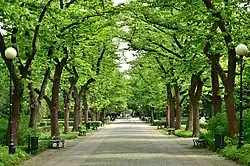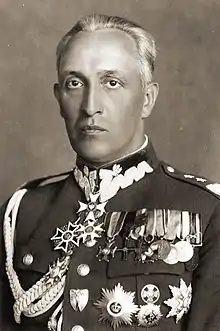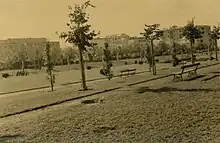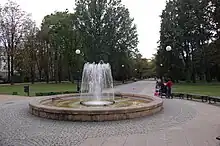| General Gustaw Orlicz-Dreszer Park | |
|---|---|
 The main avenue of the Dreszer Park in 2018. | |
| Type | Urban park |
| Location | Warsaw, Poland |
| Coordinates | 52°11′51″N 21°01′16″E / 52.19750°N 21.02111°E |
| Area | 27,000 m² (290,626 sq ft.)[1] |
| Created | 1938 |
| Designer | Zygmunt Hellwig |
The General Gustaw Orlicz-Dreszer Park,[lower-alpha 1] also simply known as Dreszer Park,[lower-alpha 2] is an urban park in the city of Warsaw, Poland, in the district of Mokotów. It is located between Ursynowska Street, Puławska Street, Odyńca Street, and Krasickiego Street. The park was designed by Zygmunt Hellwig, and opened in 1938.[1]
Name

The urban park is named General Gustaw Orlicz-Dreszer Park (Polish: Park gen. Gustawa Orlicz-Dreszera), commonly shortened to as Dreszer Park (Polish: Park Dreszera). It is named after Gustaw Orlicz-Dreszer (1889−1936), a military officer, who had served in the Polish Legions, and later, in the Polish Armed Forces. He died in 1936 in a plane crash, two years before the park was opened in 1938.[2][3]
From 1951 to 2012, the park was officially known as Mokotów Park (Polish: Park Mokotowski), named after the city district of Mokotów, in which it is located.[4][5] The local population kept referring to it by its previous name.[2][6] In March 2012, the name was reverted.[5]
The name of the park in Polish, Park gen. Gustawa Orlicz-Dreszera (General Gustaw Orlicz-Dreszer Park), is incorrect in accordance with the rules of Polish grammar. The surname Orlicz-Dreszer, present in the name, is incorrectly declined as Orlicz-Dreszera, while it should be declined as Orlicza-Dreszera. In 2019, the Warsaw City Council decided against changing the name to the version with proper declination.[7]
History

The Dreszer Park was opened on 26 June 1938. It was designed by Zygmunt Hellwig in the modernist style, and partially built in place of the rampart of the former Fort M-Che.[4][8] In the opening ceremony participated Stefan Starzyński, the mayor of Warsaw, and high-ranking officers of the Polish Armed Forces.[9] The park was located between current Ursynowska Street, Independence Avenue, Odyńca Street, and Krasickiego Street.[1]

In 1944, during the Second World War, the park became a defensive point of the Polish resistance fighters of the Warsaw Uprising, mainly from the Baszta Regiment Group, who defended their position from German forces attacking from the north between 2 and 13 August 1944, and from the south, between 25 and 27 September 1944.[10][11] During the war the park was used as a provisional cemetery, both for the fallen Polish resistance fighters and the civilian casualties.[4] After the end of the conflict, the bodies were exhumated and relocated to the proper cemmentaries.[11]
The park was restored and reopened in 1951.[11] The western portion of the park, located between Ursynowska Street, Odyńca Street, Krasickiego Street, and Independence Avenue, was separated from the rest, forming the Second Jordan Garden, one of the Jordan gardens in the city, which form urban green spaces dedicated as the recreational and play area for youth.[12][1]
In 1983, the park was given the status of a cultural property.[13]
In 1985, in the park was unveiled the Monument of Fighting Mokotów of 1944, designed by Eugeniusz Ajewski. It is dedicated to Polish resistance fighters, mainly from the Baszta Regiment Group, who had fought in the park in 1944 during the Warsaw Uprising.[1][10]
In 2007, the entirety of the soil in the park was revegetated. During the process, in the park was also built a fountain, children's playground, and public toilets, lighting was installed, and a fence was built around the park.[11]
Characteristics

The Dreszer Park is located in the city of Warsaw, Poland, in the district of Mokotów, in the City Information System area of Wierzbno.[1][14] It is placed between Ursynowska Street, Puławska Street, Odyńca Street, and Krasickiego Street.[1]
The park consists of a main avenue, and adjacent pathways, with trees growing alongside them.[1][4] It is one of the most popular parks in the city. The park has an area of 27,000 m2 (290,626 sq ft.).[1]

In the park is located the Monument of Fighting Mokotów of 1944 (also known as the Monument of Mokotów Insurgents), dedicated to Polish resistance fighters, mainly from the Baszta Regiment Group, who fought in the park in 1944 during the Warsaw Uprising. The monument, designed by Eugeniusz Ajewski, and unveiled in 1985, consists of a glacial erratic rock broken into two parts, with a sculpture of the Kotwica, which, during the Second World War, served as the emblem of the Polish Underground State, and the Home Army. It is a ligature of the letters P and W, symbolizing term Polska Walcząca, which in Polish, means Fighting Poland. In front of the sculpture is placed a plaque with a text commemorating the fighters. In front of the monument are held annual commemorative celebrations.[1][10]
Next to the park, between Ursynowska Street, Odyńca Street, Krasickiego Street, and Independence Avenue, is located the Second Jordan Garden (Polish: II Ogród Jordański), one of the Jordan gardens in the city, which form urban green spaces dedicated as the recreational and play area for children and youth. It is located between Ursynowska Street, Odyńca Street, Krasickiego Street, and Independence Avenue.[12]
Notes
References
- 1 2 3 4 5 6 7 8 9 10 "Park Dreszera". eko.um.warszawa.pl (in Polish).
- 1 2 "Nie będzie ronda Miłosierdzia Bożego. Zostaje też Żaba". warszawa.wyborcza.pl (in Polish). 8 March 2012.
- ↑ Bartosz Gondek (17 July 2018). "Ostatni lot generała Orlicz-Dreszera. 82 lata temu doszło do tajemniczej tragedii". trojmiasto.wyborcza.pl (in Polish).
- 1 2 3 4 Marian Gajewski: Urządzenia komunalne Warszawy. Zarys historyczny. Warsaw: Państwowy Instytut Wydawniczy, 1979, p. 352. ISBN 83-06-00089-7. (in Polish)
- 1 2 Uchwała nr XXXIII/807/2012 Rady Miasta Stołecznego Warszawy z dnia 8 marca 2012 r. w sprawie zmiany nazwy parku w Dzielnicy Mokotów m.st. Warszawy. In: Dziennik Urzędowy Województwa Mazowieckiego 2012 roku, no. 3347. Warsaw. Masovian Voivoideship Sejmik. 16 April 2012. (in Polish)
- ↑ Tadeusz Podgórski: Zwiedzamy Warszawę. Warsaw: Sport i Turystyka, 1956, p. 258. (in Polish)
- ↑ Jarosław Osowski: Kiedy patron ulicy ma podwójne nazwisko. In: Gazeta Stołeczna. p. 4, 9 January 2019.
- ↑ Lech Królikowski: Twierdza Warszawa, Warsaw, 2002. (in Polish)
- ↑ Krzysztof Traczyński: Park Dreszera. In: Stolica, p. 19–20, July 2019. (in Polish)
- 1 2 3 Lesław M. Bartelski: Mokotów. Warszawskie Termopile 1944. Warsaw: Fundacja Warszawa Walczy 1939-1945, 2004, p. 195-196. ISBN 83-11-09806-9. (in Polish)
- 1 2 3 4 Krzysztof Traczyński. Park Dreszera. In: Stolica, p. 20-21, July 2019. (in Polish)
- 1 2 "II Ogród Jordanowski". bip.gov.pl (in Polish).
- ↑ "Zestawienie zabytków nieruchomych. Wykaz zabytków nieruchomych wpisanych do rejestru zabytków – stan na 31 grudnia 2017 r. Woj. mazowieckie (Warszawa)". nid.pl (in Polish). 2017.
- ↑ "Obszary MSI. Dzielnica Mokotów". zdm.waw.pl (in Polish).
External links
 Media related to Park Dreszera at Wikimedia Commons
Media related to Park Dreszera at Wikimedia Commons